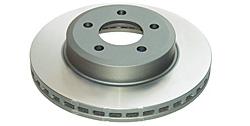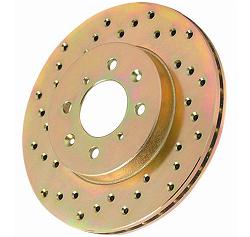 |
| Disc Brakes |
Most of us realize that the days of stopping a car Fred Flintstone style were over with the invention of 65-mph speed limits and super highways. When we stomp on the brake pedal and our one ton vehicle actually stops, there is a whole lot more to the process than simply pressing the brake pads against the disc to make the car stop.
Three major scientific actions come to play to create enough force to stop a vehicle moving at 65 mph with four adults and a huge load of after Christmas sales deals. Friction, hydraulics and leverage all work together to make certain that your loved ones arrive safely at their final destinations.
The disc brake units consist of brake pads, calipers (containing the piston) and the rotor which is mounted on the hub or wheel of the car. In the disc brake design, the brake pads are pressed against the rotor hydraulically. The friction created between the brake pads and the disc slows the vehicle.
The kinetic energy created by such a large mass in motion has to be addressed as well in order to create a stopping mechanism that doesn’t overheat the brakes. To achieve this, disc brakes are typically vented. To cool the disc pads, two cooling veins run along side the discs and pump cooling air to the brake pads.
 |
| Cross Drilled Brake Disc - Efficiently Displace Heat |
Maintaining your vehicle’s brakes in good condition is essential to the safety of your vehicle. Once the initial wear and tear has passed on your disc brakes you will begin to note a metal on metal sound every time you brake. Eventually, the brakes will start to grab as a result of the brake pads wearing down to metal and grabbing onto the rotor. At this point, you can anticipate a much more expensive repair, possibly even replacing the rotors instead of just turning them.
Replacing the brake pads yourself is inexpensive and will lengthen the life of your car. Replacing brake pads should be considered a part of regular maintenance just as changing your oil and air filter is. Generally, brake pads will run between $10 and $50 depending on the car and quality of brake pads. Some brake pads can even be purchased with a lifetime warranty so you simply exchange the old, worn brake pads for a new set when they become worn.